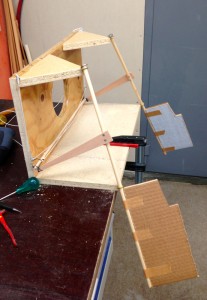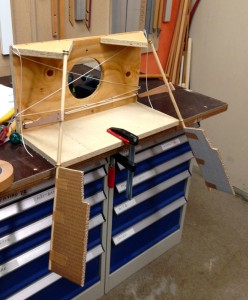YRVIND-TEN has two rudders. They are angled outwards 20 degrees and backwards 20 degrees. They pivot (not shown in the modell) as not to break if hitting ice or taking the ground. Each rudder has a top and a bottom bearing. Between them is the tiller or arm. A rod connects the two rudders via the arms. The connecting rod is telescopic. ( not shown)The reason is that in strong following winds each rudder can be angled outwards by shortening the connecting rod. This has a bit the same effect as a drogue. It slows the boat down and make it directional stable. If the boat deviates from it downward course the lee rudder gets a bigger angle of attack while the windward rudder will get less angle of attack. The resulting force will restore the boat to its downwind track.
The steering is done with ropes. Tackles (not shown) provide the correct power ratio.
The bottom bearings is fastened to platform close to the water handy when getting in and out of the water. I intend to swim every day if the weather is not to bad. That will contribute to keep me fit. There is a step on each rudder.
This platform makes it easy to raise and lower the rudders. Hopefully I will develop a water generator that fit the lower part of the rudder, likewise a foil that with the help of wave power propels the boat in calms.
The pictures below show the first model. The scale is 1:2. The real product will be bolted to the transom with four screws. The model is very rough, not more than a mock up and many details are not included. If the concept is difficult to grasp blame me. Better models and explanations will be shown in course of the building.
The connecting rod and the stearing ropes can be seen where the plywood is screved to the particle board. That position is chosen so that it will not interfere with me getting in and out of the water. I have used pieces from my scrap pile. the big round hole has nothing to do with this project.
In the picture below the stearing lines can be seen crossing each other on the transom. The crossing is to make the boat stear the conventional way. One can also re-learn. I chose to go conventional. Not everyone does. A freind of mine reads upside down. He learnt to read himself at a young age by looking at his fathers newspapers across the breacfast table. He can also read the conventional way. Click on the pictures once or twice to enlarge them.
ADDENDUM Sunday 18 Nov 2012
After sleeping on it I realsise that if I add one more sheave to the block fastened to the connecting bar the ropes do not have to cross each other. That will be a neater solution.
To be continued…
Regards Yrvind.


